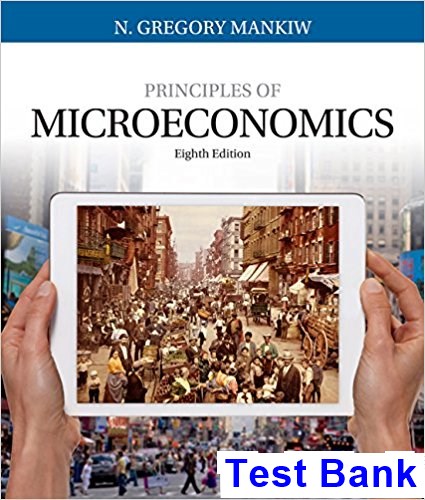Principles of Microeconomics 8th Edition Mankiw Test Bank

Product details:
- ISBN-10 : 1305971493
- ISBN-13 : 978-1305971493
- Author: N. Gregory Mankiw
Now you can master the principles of microeconomics with the help of the most popular, widely-used economics textbook by students worldwide — Mankiw�s PRINCIPLES OF MICROECONOMICS, 8E. With its clear and engaging writing style, this book emphasizes only the material that will help you better understand the world in which you live, will make you a more astute participant in the economy, and will give you a better understanding of both the potential and limits of economic policy. The latest relevant examples bring microeconomic principles to life. Acclaimed text author N. Gregory Mankiw explains, “I have tried to put myself in the position of someone seeing economics for the first time. My goal is to emphasize the material that students should and do find interesting about the study of the economy.” The powerful MindTap student-focused digital resource is available and sold separately. Its digital learning and homework solutions reinforce the principles presented in this edition.
Table contents:
- Part I: Introduction
- Chapter 1: Ten Principles of Economics
- 1-1 How People Make Decisions
- 1-1a Principle 1: People Face Trade-offs
- 1-1b Principle 2: The Cost of Something Is What You Give Up to Get It
- 1-1c Principle 3: Rational People Think at the Margin
- 1-1d Principle 4: People Respond to Incentives
- 1-2 How People Interact
- 1-2a Principle 5: Trade Can Make Everyone Better Off
- 1-2b Principle 6: Markets Are Usually a Good Way to Organize Economic Activity
- FYI: Adam Smith and the Invisible Hand
- Case Study: Adam Smith Would Have Loved Uber
- 1-2c Principle 7: Governments Can Sometimes Improve Market Outcomes
- 1-3 How the Economy as a Whole Works
- 1-3a Principle 8: A Country’s Standard of Living Depends on Its Ability to Produce Goods and Serv
- 1-3b Principle 9: Prices Rise When the Government Prints Too Much Money
- 1-3c Principle 10: Society Faces a Short-Run Trade-off between Inflation and Unemployment
- 1-4 Conclusion
- Summary
- Key Concepts
- Questions for Review
- Problems and Applications
- Chapter 2: Thinking Like an Economist
- 2-1 The Economist as Scientist
- 2-1a The Scientific Method: Observation, Theory, and More Observation
- 2-1b The Role of Assumptions
- 2-1c Economic Models
- 2-1d Our First Model: The Circular-Flow Diagram
- 2-1e Our Second Model: The Production Possibilities Frontier
- 2-1f Microeconomics and Macroeconomics
- 2-2 The Economist as Policy Adviser
- 2-2a Positive versus Normative Analysis
- 2-2b Economists in Washington
- 2-2c Why Economists’ Advice Is Not Always Followed
- 2-3 Why Economists Disagree
- 2-3a Differences in Scientific Judgments
- 2-3b Differences in Values
- 2-3c Perception versus Reality
- Ask The Experts: Ticket Resale
- 2-4 Let’s Get Going
- In The News: Why You Should Study Economics
- Summary
- Key Concepts
- Questions for Review
- Problems and Applications
- Appendix Graphing: A Brief Review
- Chapter 3: Interdependence and the Gains from Trade
- 3-1 A Parable for the Modern Economy
- 3-1a Production Possibilities
- 3-1b Specialization and Trade
- 3-2 Comparative Advantage: The Driving Force of Specialization
- 3-2a Absolute Advantage
- 3-2b Opportunity Cost and Comparative Advantage
- 3-2c Comparative Advantage and Trade
- 3-2d The Price of the Trade
- FYI: The Legacy of Adam Smith and David Ricardo
- 3-3 Applications of Comparative Advantage
- 3-3a Should Serena Williams Mow Her Own Lawn
- In The News: Economics within a Marriage
- 3-3b Should the United States Trade with Other Countries
- Ask The Experts: Trade between China and the United States
- 3-4 Conclusion
- Summary
- Key Concepts
- Questions for Review
- Problems and Applications
- Part II: How Markets Work
- Chapter 4: The Market Forces of Supply and Demand
- 4-1 Markets and Competition
- 4-1a What Is a Market
- 4-1b What Is Competition
- 4-2 Demand
- 4-2a The Demand Curve: The Relationship between Price and Quantity Demanded
- 4-2b Market Demand versus Individual Demand
- 4-2c Shifts in the Demand Curve
- Case Study: Two Ways to Reduce the Quantity of Smoking Demanded
- 4-3 Supply
- 4-3a The Supply Curve: The Relationship between Price and Quantity Supplied
- 4-3b Market Supply versus Individual Supply
- 4-3c Shifts in the Supply Curve
- 4-4 Supply and Demand Together
- 4-4a Equilibrium
- 4-4b Three Steps to Analyzing Changes in Equilibrium
- 4-5 Conclusion: How Prices Allocate Resources
- Ask The Experts: Price Gouging
- In The News: Price Increases after Disasters
- Summary
- Key Concepts
- Questions for Review
- Problems and Applications
- Chapter 5: Elasticity and Its Application
- 5-1 The Elasticity of Demand
- 5-1a The Price Elasticity of Demand and Its Determinants
- 5-1b Computing the Price Elasticity of Demand
- 5-1c The Midpoint Method: A Better Way to Calculate Percentage Changes and Elasticities
- 5-1d The Variety of Demand Curves
- FYI: A Few Elasticities from the Real World
- 5-1e Total Revenue and the Price Elasticity of Demand
- 5-1f Elasticity and Total Revenue along a Linear Demand Curve
- 5-1g Other Demand Elasticities
- 5-2 The Elasticity of Supply
- 5-2a The Price Elasticity of Supply and Its Determinants
- 5-2b Computing the Price Elasticity of Supply
- 5-2c The Variety of Supply Curves
- 5-3 Three Applications of Supply, Demand, and Elasticity
- 5-3a Can Good News for Farming Be Bad News for Farmers
- 5-3b Why Did OPEC Fail to Keep the Price of Oil High
- 5-3c Does Drug Interdiction Increase or Decrease Drug-Related Crime
- 5-4 Conclusion
- Summary
- Key Concepts
- Questions for Review
- Problems and Applications
- Chapter 6: Supply, Demand, and Government Policies
- 6-1 Controls on Prices
- Case Study: Rent Control in the Short Run and the Long Run
- 6-1b How Price Floors Affect Market Outcomes
- Ask The Experts: Rent Control
- Case Study: The Minimum Wage
- Ask The Experts: The Minimum Wage
- 6-1c Evaluating Price Controls
- 6-1a How Price Ceilings Affect Market Outcomes
- Case Study: Lines at the Gas Pump
- 6-2 Taxes
- 6-2a How Taxes on Sellers Affect Market Outcomes
- 6-2b How Taxes on Buyers Affect Market Outcomes
- Case Study: Can Congress Distribute the Burden of a Payroll Tax
- 6-2c Elasticity and Tax Incidence
- Case Study: Who Pays the Luxury Tax
- 6-3 Conclusion
- Summary
- Key Concepts
- Questions for Review
- Problems and Applications
- Part III: Markets and Welfare
- Chapter 7: Consumers, Producers, and the Efficiency of Markets
- 7-1 Consumer Surplus
- 7-1a Willingness to Pay
- 7-1b Using the Demand Curve to Measure Consumer Surplus
- 7-1c How a Lower Price Raises Consumer Surplus
- 7-1d What Does Consumer Surplus Measure
- 7-2 Producer Surplus
- 7-2a Cost and the Willingness to Sell
- 7-2b Using the Supply Curve to Measure Producer Surplus
- 7-2c How a Higher Price Raises Producer Surplus
- 7-3 Market Efficiency
- 7-3a The Benevolent Social Planner
- 7-3b Evaluating the Market Equilibrium
- In The News: The Invisible Hand Can Park Your Car
- Case Study: Should There Be a Market for Organs
- Ask The Experts: Supplying Kidneys
- 7-4 Conclusion: Market Efficiency and Market Failure
- Summary
- Key Concepts
- Questions for Review
- Problems and Applications
- Chapter 8: Application: The Costs of Taxation
- 8-1 The Deadweight Loss of Taxation
- 8-1a How a Tax Affects Market Participants
- 8-1b Deadweight Losses and the Gains from Trade
- 8-2 The Determinants of the Deadweight Loss
- Case Study: The Deadweight Loss Debate
- 8-3 Deadweight Loss and Tax Revenue as Taxes Vary
- Case Study: The Laffer Curve and Supply-Side Economics
- Ask The Experts: The Laffer Curve
- 8-4 Conclusion
- Summary
- Key Concept
- Questions for Review
- Problems and Applications
- Chapter 9: Application: International Trade
- 9-1 The Determinants of Trade
- 9-1a The Equilibrium without Trade
- 9-1b The World Price and Comparative Advantage
- 9-2 The Winners and Losers from Trade
- 9-2a The Gains and Losses of an Exporting Country
- 9-2b The Gains and Losses of an Importing Country
- 9-2c Effects of a Tariff
- FYI: Import Quotas: Another Way to Restrict Trade
- 9-2d The Lessons for Trade Policy
- 9-2e Other Benefits of International Trade
- In The News: Trade as a Tool for Economic Development
- 9-3 The Arguments for Restricting Trade
- 9-3a The Jobs Argument
- In The News: Should the Winners from Free Trade Compensate the Losers
- 9-3b The National-Security Argument
- 9-3c The Infant-Industry Argument
- 9-3d The Unfair-Competition Argument
- 9-3e The Protection-as-a-Bargaining-Chip Argument
- Case Study: Trade Agreements and the World Trade Organization
- Ask The Experts: Trade Deals
- 9-4 Conclusion
- Summary
- Key Concepts
- Questions for Review
- Problems and Applications
- Part IV: The Economics of the Public Sector
- Chapter 10: Externalities
- 10-1 Externalities and Market Inefficiency
- 10-1a Welfare Economics: A Recap
- 10-1b Negative Externalities
- 10-1c Positive Externalities
- Case Study: Technology Spillovers, Industrial Policy, and Patent Protection
- 10-2 Public Policies toward Externalities
- 10-2a Command-and-Control Policies: Regulation
- 10-2b Market-Based Policy 1: Corrective Taxes and Subsidies
- Ask The Experts: Vaccines
- Case Study: Why Is Gasoline Taxed So Heavily
- In The News: What Should We Do about Climate Change
- 10-2c Market-Based Policy 2: Tradable Pollution Permits
- Ask The Experts: Carbon Taxes
- 10-2d Objections to the Economic Analysis of Pollution
- 10-3 Private Solutions to Externalities
- 10-3a The Types of Private Solutions
- 10-3b The Coase Theorem
- 10-3c Why Private Solutions Do Not Always Work
- In The News: The Coase Theorem in Action
- 10-4 Conclusion
- Summary
- Key Concepts
- Questions for Review
- Problems and Applications
- Chapter 11: Public Goods and Common Resources
- 11-1 The Different Kinds of Goods
- 11-2 Public Goods
- 11-2a The Free-Rider Problem
- 11-2b Some Important Public Goods
- Case Study: Are Lighthouses Public Goods
- 11-2c The Difficult Job of Cost–Benefit Analysis
- Case Study: How Much Is a Life Worth
- 11-3 Common Resources
- 11-3a The Tragedy of the Commons
- 11-3b Some Important Common Resources
- Ask The Experts: Congesting Pricing
- In The News: The Case for Toll Roads
- Case Study: Why the Cow Is Not Extinct
- 11-4 Conclusion: The Importance of Property Rights
- Summary
- Key Concepts
- Questions for Review
- Problems and Applications
- Chapter 12: The Design of the Tax System
- 12-1 An Overview of U.S. Taxation
- 12-1a Taxes Collected by the Federal Government
- 12-1b Taxes Collected by State and Local Governments
- 12-2 Taxes and Efficiency
- 12-2a Deadweight Losses
- Case Study: Should Income or Consumption Be Taxed
- 12-2b Administrative Burden
- 12-2c Marginal Tax Rates versus Average Tax Rates
- 12-2d Lump-Sum Taxes
- 12-3 Taxes and Equity
- 12-3a The Benefits Principle
- 12-3b The Ability-to-Pay Principle
- Case Study: How the Tax Burden Is Distributed
- 12-3c Tax Incidence and Tax Equity
- In The News: Tax Expenditures
- Case Study: Who Pays the Corporate Income Tax
- 12-4 Conclusion: The Trade-off between Equity and Efficiency
- Summary
- Key Concepts
- Questions for Review
- Problems and Applications
- Part V: Firm Behavior and the Organization of Industry
- Chapter 13: The Costs of Production
- 13-1 What Are Costs
- 13-1a Total Revenue, Total Cost, and Profit
- 13-1b Costs as Opportunity Costs
- 13-1c The Cost of Capital as an Opportunity Cost
- 13-1d Economic Profit versus Accounting Profit
- 13-2 Production and Costs
- 13-2a The Production Function
- 13-2b From the Production Function to the Total-Cost Curve
- 13-3 The Various Measures of Cost
- 13-3a Fixed and Variable Costs
- 13-3b Average and Marginal Cost
- 13-3c Cost Curves and Their Shapes
- 13-3d Typical Cost Curves
- 13-4 Costs in the Short Run and in the Long Run
- 13-4a The Relationship between Short-Run and Long-Run Average Total Cost
- 13-4b Economies and Diseconomies of Scale
- FYI: Lessons from a Pin Factory
- 13-5 Conclusion
- Summary
- Key Concepts
- Questions for Review
- Problems and Applications
- Chapter 14: Firms in Competitive Markets
- 14-1 What Is a Competitive Market
- 14-1a The Meaning of Competition
- 14-1b The Revenue of a Competitive Firm
- 14-2 Profit Maximization and the Competitive Firm’s Supply Curve
- 14-2a A Simple Example of Profit Maximization
- 14-2b The Marginal-Cost Curve and the Firm’s Supply Decision
- 14-2c The Firm’s Short-Run Decision to Shut Down
- 14-2d Spilt Milk and Other Sunk Costs
- Case Study: Near-Empty Restaurants and Off-Season Miniature Golf
- 14-2e The Firm’s Long-Run Decision to Exit or Enter a Market
- 14-2f Measuring Profit in Our Graph for the Competitive Firm
- 14-3 The Supply Curve in a Competitive Market
- 14-3a The Short Run: Market Supply with a Fixed Number of Firms
- 14-3b The Long Run: Market Supply with Entry and Exit
- 14-3c Why Do Competitive Firms Stay in Business If They Make Zero Profit
- 14-3d A Shift in Demand in the Short Run and Long Run
- 14-3e Why the Long-Run Supply Curve Might Slope Upward
- 14-4 Conclusion: Behind the Supply Curve
- Summary
- Key Concepts
- Questions for Review
- Problems and Applications
- Chapter 15: Monopoly
- 15-1 Why Monopolies Arise
- 15-1a Monopoly Resources
- 15-1b Government-Created Monopolies
- 15-1c Natural Monopolies
- 15-2 How Monopolies Make Production and Pricing Decisions
- 15-2a Monopoly versus Competition
- 15-2b A Monopoly’s Revenue
- 15-2c Profit Maximization
- 15-2d A Monopoly’s Profit
- FYI: Why a Monopoly Does Not Have a Supply Curve
- Case Study: Monopoly Drugs versus Generic Drugs
- 15-3 The Welfare Cost of Monopolies
- 15-3a The Deadweight Loss
- 15-3b The Monopoly’s Profit: A Social Cost
- 15-4 Price Discrimination
- 15-4a A Parable about Pricing
- 15-4b The Moral of the Story
- 15-4c The Analytics of Price Discrimination
- 15-4d Examples of Price Discrimination
- In The News: Price Discrimination in Higher Education
- 15-5 Public Policy toward Monopolies
- 15-5a Increasing Competition with Antitrust Laws
- 15-5b Regulation
- Ask The Experts: Airline Mergers
- 15-5c Public Ownership
- 15-5d Doing Nothing
- 15-6 Conclusion: The Prevalence of Monopolies
- Summary
- Key Concepts
- Questions for Review
- Problems and Applications
- Chapter 16: Monopolistic Competition
- 16-1 Between Monopoly and Perfect Competition
- 16-2 Competition with Differentiated Products
- 16-2a The Monopolistically Competitive Firm in the Short Run
- 16-2b The Long-Run Equilibrium
- 16-2c Monopolistic versus Perfect Competition
- 16-2d Monopolistic Competition and the Welfare of Society
- 16-3 Advertising
- 16-3a The Debate over Advertising
- Case Study: Advertising and the Price of Eyeglasses
- 16-3b Advertising as a Signal of Quality
- 16-3c Brand Names
- 16-4 Conclusion
- Summary
- Key Concepts
- Questions for Review
- Problems and Applications
- Chapter 17: Oligopoly
- 17-1 Markets with Only a Few Sellers
- 17-1a A Duopoly Example
- 17-1b Competition, Monopolies, and Cartels
- 17-1c The Equilibrium for an Oligopoly
- 17-1d How the Size of an Oligopoly Affects the Market Outcome
- Ask The Experts: Nash Equilibrium
- 17-2 The Economics of Cooperation
- 17-2a The Prisoners’ Dilemma
- 17-2b Oligopolies as a Prisoners’ Dilemma
- Case Study: OPEC and the World Oil Market
- 17-2c Other Examples of the Prisoners’ Dilemma
- 17-2d The Prisoners’ Dilemma and the Welfare of Society
- 17-2e Why People Sometimes Cooperate
- Case Study: The Prisoners’ Dilemma Tournament
- 17-3 Public Policy toward Oligopolies
- 17-3a Restraint of Trade and the Antitrust Laws
- Case Study: An Illegal Phone Call
- 17-3b Controversies over Antitrust Policy
- Case Study: The Microsoft Case
- In The News: Europe versus Google
- 17-4 Conclusion
- Summary
- Key Concepts
- Questions for Review
- Problems and Applications
- Part VI: The Economics of Labor Markets
- Chapter 18: The Markets for the Factors of Production
- 18-1 The Demand for Labor
- 18-1a The Competitive Profit-Maximizing Firm
- 18-1b The Production Function and the Marginal Product of Labor
- 18-1c The Value of the Marginal Product and the Demand for Labor
- 18-1d What Causes the Labor-Demand Curve to Shift
- FYI: Input Demand and Output Supply: Two Sides of the Same Coin
- 18-2 The Supply of Labor
- 18-2a The Trade-off between Work and Leisure
- 18-2b What Causes the Labor-Supply Curve to Shift
- Ask The Experts: Immigration
- 18-3 Equilibrium in the Labor Market
- 18-3a Shifts in Labor Supply
- 18-3b Shifts in Labor Demand
- In The News: The Economics of Immigration
- Case Study: Productivity and Wages
- FYI: Monopsony
- 18-4 The Other Factors of Production: Land and Capital
- 18-4a Equilibrium in the Markets for Land and Capital
- FYI: What Is Capital Income
- 18-4b Linkages among the Factors of Production
- Case Study: The Economics of the Black Death
- 18-5 Conclusion
- Summary
- Key Concepts
- Questions for Review
- Problems and Applications
- Chapter 19: Earnings and Discrimination
- 19-1 Some Determinants of Equilibrium Wages
- 19-1a Compensating Differentials
- 19-1b Human Capital
- Case Study: The Increasing Value of Skills
- Ask The Experts: Inequality and Skills
- In The News: Schooling as a Public Investment
- 19-1c Ability, Effort, and Chance
- Case Study: The Benefits of Beauty
- 19-1d An Alternative View of Education: Signaling
- 19-1e The Superstar Phenomenon
- 19-1f Above-Equilibrium Wages: Minimum-Wage Laws, Unions, and Efficiency Wages
- 19-2 The Economics of Discrimination
- 19-2a Measuring Labor-Market Discrimination
- Case Study: Is Emily More Employable than Lakisha
- 19-2b Discrimination by Employers
- Case Study: Segregated Streetcars and the Profit Motive
- 19-2c Discrimination by Customers and Governments
- Case Study: Discrimination in Sports
- 19-3 Conclusion
- Summary
- Key Concepts
- Questions for Review
- Problems and Applications
- Chapter 20: Income Inequality and Poverty
- 20-1 The Measurement of Inequality
- 20-1a U.S. Income Inequality
- 20-1b Inequality around the World
- In The News: A Worldwide View of the Income Distribution
- 20-1c The Poverty Rate
- 20-1d Problems in Measuring Inequality
- Case Study: Alternative Measures of Inequality
- 20-1e Economic Mobility
- 20-2 The Political Philosophy of Redistributing Income
- 20-2a Utilitarianism
- 20-2b Liberalism
- 20-2c Libertarianism
- 20-3 Policies to Reduce Poverty
- 20-3a Minimum-Wage Laws
- 20-3b Welfare
- 20-3c Negative Income Tax
- 20-3d In-Kind Transfers
- 20-3e Antipoverty Programs and Work Incentives
- In The News: International Differences in Income Redistribution
- 20-4 Conclusion
- Summary
- Key Concepts
- Questions for Review
- Problems and Applications
- Part VII: Topics for Further Study
- Chapter 21: The Theory of Consumer Choice
- 21-1 The Budget Constraint: What the Consumer Can Afford
- 21-2 Preferences: What the Consumer Wants
- 21-2a Representing Preferences with Indifference Curves
- 21-2b Four Properties of Indifference Curves
- 21-2c Two Extreme Examples of Indifference Curves
- 21-3 Optimization: What the Consumer Chooses
- 21-3a The Consumer’s Optimal Choices
- FYI: Utility: An Alternative Way to Describe Preferences and Optimization
- 21-3b How Changes in Income Affect the Consumer’s Choices
- 21-3c How Changes in Prices Affect the Consumer’s Choices
- 21-3d Income and Substitution Effects
- 21-3e Deriving the Demand Curve
- 21-4 Three Applications
- 21-4a Do All Demand Curves Slope Downward
- Case Study: The Search for Giffen Goods
- 21-4b How Do Wages Affect Labor Supply
- Case Study: Income Effects on Labor Supply: Historical Trends, Lottery Winners, and the Carnegie Co
- 21-4c How Do Interest Rates Affect Household Saving
- 21-5 Conclusion: Do People Really Think This Way
- Summary
- Key Concepts
- Questions for Review
- Problems and Applications
- Chapter 22: Frontiers of Microeconomics
- 22-1 Asymmetric Information
- 22-1a Hidden Actions: Principals, Agents, and Moral Hazard
- FYI: Corporate Management
- 22-1b Hidden Characteristics: Adverse Selection and the Lemons Problem
- 22-1c Signaling to Convey Private Information
- Case Study: Gifts as Signals
- 22-1d Screening to Uncover Private Information
- 22-1e Asymmetric Information and Public Policy
- 22-2 Political Economy
- 22-2a The Condorcet Voting Paradox
- 22-2b Arrow’s Impossibility Theorem
- 22-2c The Median Voter Is King
- 22-2d Politicians Are People Too
- 22-3 Behavioral Economics
- 22-3a People Aren’t Always Rational
- 22-3b People Care about Fairness
- In The News: Using Deviations from Rationality
- 22-3c People Are Inconsistent over Time
- 22-4 Conclusion
- Summary
- Key Concepts
- Questions for Review
- Problems and Applications
- Glossary
- Index
People also search:
principles of microeconomics 8th edition
principles of microeconomics mankiw 8th edition answer key
principles of microeconomics 8th edition by n. gregory mankiw
principles of microeconomics by gregory mankiw 8th edition
principles of macroeconomics 8th edition
principles of microeconomics 8th edition n. gregory mankiw





